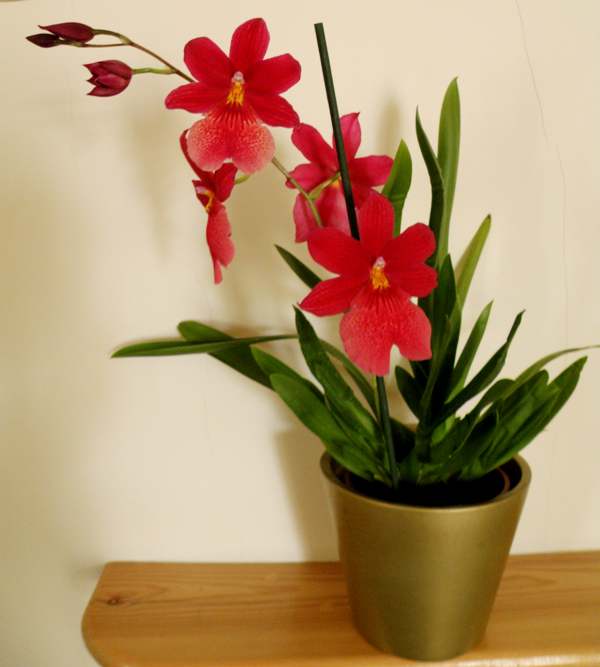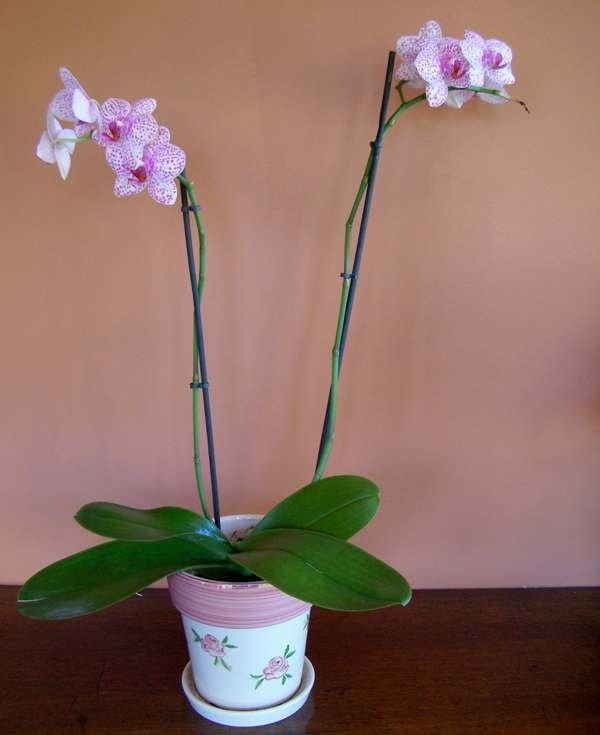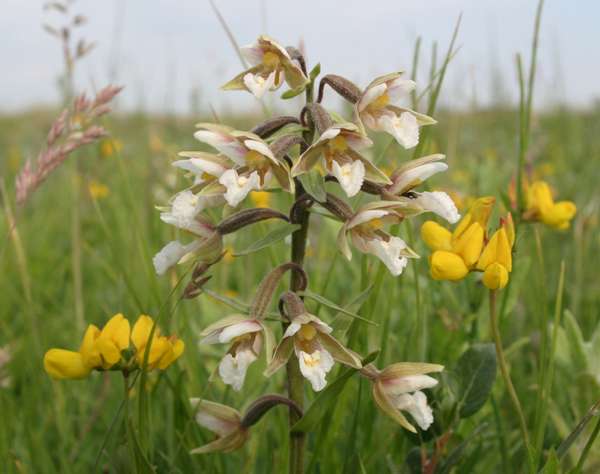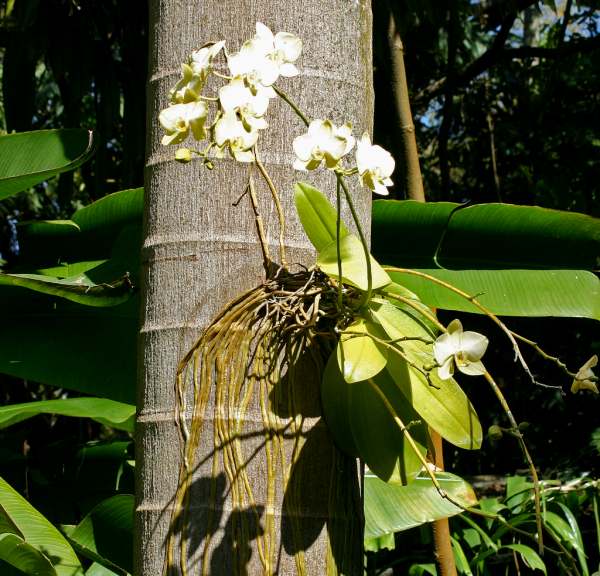Trees Birds Mammals Fish Amphibians Reptiles
Wild Algarve
Bookshop
Caring for Orchids as House plants

If like me you are ‘unlucky’ with house plants, try some orchids – not the wild terrestrial orchids found in Britain and Europe, of course, which simply don’t survive being moved indoors or into gardens, but some of the many (mainly tropical) orchids that are available through garden centres and nurseries. They are seriously low maintenance!
There are many types to choose from including:

The real duffer-proof variety is the tropical Phalaenopsis hybrids (don’t panic – their common name is Moth Orchid) and these are also the most frequently stocked variety, especially in supermarkets and, let’s face it, you have to be tough to survive the regime at Tesco or Morrison where the top priority is not training the staff in horticulture! This is all you have to do:
Place the plant in a warm (anything above 15 degrees C is fine) and draft-free room in indirect light – not on a window-ledge that gets direct sunlight all day. After that, all you have to do is water the plant once a week by immersing the whole pot in water for several hours – or overnight. Once you get the regime right, Moth Orchids will keep their flowers for up to 6 months! Forget cut flowers that cost a fortune and last for a week if you are lucky; just buy a Moth Orchid every now and then.
Once it has stopped flowering, cut the flower stem down to about half an inch in height and continue in exactly the same way and, guess what? It will grow a new leaf and very soon after a new flower shoot will appear. You can expect a Moth Orchid to flower about once a year so, as the flowers can last up to 6 months, you will have a beautiful spray of orchids nearly all the time.
Once you have gained a bit of confidence, you can move on and try some of the other types of orchids available in nurseries. On these pages, you will find pictures of several of them, and basic information about the countries they come from and the conditions in which they live in the wild. The watering routine is exactly the same as above; they do not flower as long as the Moth Orchids – but still far longer than any cut flower I have come across.

All orchid hybrids are relatives of those once found in the wild, and a little bit of knowledge about their habitat can be a good guide to the kind of care they need. If a plant only gets rained on every six months, a daily dousing is clearly not going to suit it! Similarly, a tropical orchid, used to regular and torrential rain showers, is not going to be too happy being watered once a month and put to live in a freezing cold porch. In addition it is useful to know if a particular plant is a terrestrial or epiphytic orchid.
Terrestrial orchids are those that grow on the ground, and this applies to our European species that grow in meadows, fields and mountain sides etc. They grow with bulbs, or rhizomes and roots below ground.

Epiphytic orchids are found in rainforests and grow on the branches and trunks of trees, which they use as ‘perches’, thus escaping from the competition of all the other plants to be found on the forest floor. They should not be confused with parasitic plants which actively draw nourishment from the tree or plant on which they are found; epiphytes simply use the host as a means of support.
Do not expect any orchids to appear firmly ‘rooted’ in pots under loads of compost. Many healthy plants appear to have totally exposed and pot-bound roots but they thrive, producing flower after flower. An epiphytic orchid, in particular, is really just ‘perched’ perilously on the top of the compost in the pot, and so it will easily fall out if tilted. Never fear, just perch it back on the compost and carry on as normal. Remember... it thinks it’s living on a branch!
Find out more about orchids.
Wild Orchids are one of the largest groups of flowering plants. To date up to around 30,000 different species have been identified with more being found every year. These amazing plants are to be found all over the world in forests, on mountains and even in deserts. Establishing a date when man first found and cultivated wild orchids is difficult but it is widely believed that the Japanese and Chinese were the first to grow them, around three thousand years ago.
In Europe we can find evidence that the Greeks, in the pre-Roman period, knew about and studied wild orchids. Many of the plants were used as medicines, although the use of orchids as herbal remedies ceased after the Middle Ages. Today, wild orchids still grow and flower in large numbers throughout the Mediterranean region, starting in February and continuing right through to the start of the hot, dry summer around the end of May.
In more recent times a burgeoning interest in orchids was stimulated by the explorers bringing back plants of all kinds from their journeys, which were mainly to Europe until the mid-sixteenth century when America was discovered and colonised. In Victorian times interest in plants became almost an obsession. Many wealthy individuals sponsored trips to all manner of remote and dangerous places so that they could be the first to show off an exotic new discovery in their glasshouses or gardens. The stories of these courageous ‘Plant Hunters’ make exciting reading and I strongly recommend The Plant Hunters by Toby Musgrave, Chris Gardener and Will Musgrave first published as a paperback in 1999 by Seven Dials (ISBN 1-84188-001-9). The book is beautifully illustrated and the stories are thrilling.
Orchid classification and naming
The overall name for all the plants in the orchid family is Orchidaceae, and within that family the plants are divided into sub-tribes from which they are divided again into different genera, for example, Odontoglossum, and then into individual species; thus a particular species of Odontoglossum would be identified by its second name becoming, for example, Odontoglossom crispum, which identifies it as a species of Odontoglossum called crispum.
The most commonly available orchids from garden centres and flower shops for use as house plants are Phalaenopsis, Odontoglossum, Cymbidium, Dendrobium, Paphiopedilum/Cypripedium, Miltonia and . In addition there is a small genus called Pleione which can be grown outside. Follow the links below for details of how to create an orchid-friendly environment for the most popular pot plant orchids.
You can find care guides for other kinds of orchids on The Green Pinky...
Top of page...
Sue Parker's latest ebook is a revised and enlarged edition of Wild Orchids in The Burren. Full details here...
Buy it for just £5.95 on Amazon...
Sue Parker's new ebook is a comprehensive and fully revised edition of her acclaimed field guide to the Wild Orchids of Wales. Full details here...
Buy it for just £5.95 on Amazon...
Please Help Us: If you have found this information interesting and useful, please consider helping to keep First Nature online by making a small donation towards the web hosting and internet costs.
Any donations over and above the essential running costs will help support the conservation work of Plantlife, the Rivers Trust and charitable botanic gardens - as do author royalties and publisher proceeds from books by Pat and Sue.